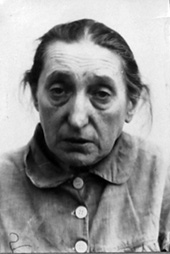Search for Names, Places and Biographies
Already layed Stumbling Stones
Suche
Bertha Nürenberg (née Heinemann) * 1874
Grindelhof 83 (Eimsbüttel, Rotherbaum)
HIER WOHNTE
BERTHA NÜRENBERG
GEB. HEINEMANN
JG. 1874
EINGEWIESEN 1935
HEILANSTALT LANGENHORN
"VERLEGT" 23.9.1940
BRANDENBURG
ERMORDET 23.9.1940
"AKTION T4"
further stumbling stones in Grindelhof 83:
Leopold Bielefeld, Erna Brociner, Valentina Brociner, Kurt Ehrenberg, Heinrich Kempler, Rosa Kempler, Herbert Lesheim, Bert(h)a Lesheim, Ruth Lesheim, Marion Lesheim, Tana Lesheim, Mary Liebreich, Hugo Moses
Bertha Nürenberg, née Heinemann, born on 24 Oct. 1874 in Oberwaldbehrungen (Lower Franconia), murdered on 23 Sept. 1940 in the "euthanasia” killing center in Brandenburg/Havel
Grindelhof 83
Bertha Heinemann, born in Oberwaldbehrungen in Lower Franconia on 24 Oct. 1874, was married to the electrical engineer Osias Nürenberg, born in Bucharest on 5 Dec. 1880.
Bertha’s Jewish parents had married on 10 Dec. 1872 in Mellrichstadt, also in Lower Franconia. Her first child was stillborn on 22 Sept. 1873. After Bertha, the son Simon Heinemann was born as the third child.
We know nothing about Bertha’s life up to her marriage.
Bertha Nürenberg’s husband was also of the Jewish faith. He had Romanian citizenship. The childless couple resided in Hamburg since 1911. The residents’ registration file shows many changing addresses. At times, Osias Nürenberg lived in Berlin and returned to Hamburg via Altona. From Nov. 1923 to Aug. 1924, he served a penal sentence in the Fuhlsbüttel prison. In 1926, he finally left Hamburg permanently. Bertha Nürenberg’s husband was probably not a reliable support for her even during his Hamburg years. After his departure, she was finally on her own.
Bertha Nürenberg, whose occupation was listed as a cook, lived at Grindelhof 83 House 5, as a subtenant with Reimers.
On 29 Aug. 1932, she was admitted to Eppendorf General Hospital because of a mental illness diagnosed by her family doctor Ernst Kalmus. Bertha did not accept the necessity of the hospital stay. She considered herself healthy and wished to be discharged home. On 9 Dec. 1932, she was transferred to the Friedrichsberg State Hospital (Staatskrankenanstalt Friedrichsberg). She was unable to orientate herself sufficiently in space and time, but was still convinced that she was not ill.
On 16 Apr. 1935, Bertha Nürenberg was first admitted to the Oberaltenallee care home (Versorgungsheim Oberaltenallee) and then in the Averhoffstrasse nursing home. A short time later, on 22 Aug. 1935, she was admitted to the Langenhorn State Hospital (Staatskrankenanstalt Langenhorn), remaining there for the next five years.
In the spring/summer of 1940, the "euthanasia” headquarters in Berlin, located at Tiergartenstrasse 4, planned a special operation aimed against Jews in public and private sanatoriums and nursing homes. It had the Jewish persons living in the institutions registered and moved together in what were officially so-called collection institutions. The Hamburg-Langenhorn "sanatorium and nursing home” ("Heil- und Pflegeanstalt” Hamburg-Langenhorn) was designated the North German collection institution. All institutions in Hamburg, Schleswig-Holstein, and Mecklenburg were ordered to move the Jews living in their facilities there by 18 Sept. 1940.
After all Jewish patients from the North German institutions had arrived in Langenhorn, they were taken to Brandenburg/Havel on 23 Sept. 1940, together with the Jewish patients who had lived there for some time, on a transport comprised of 136 persons overall. On the same day, they were killed with carbon monoxide in the part of the former penitentiary converted into a gas-killing facility. Only one patient, Ilse Herta Zachmann, escaped this fate at first (see corresponding entry).
It is not known whether, and if so, when relatives became aware of Bertha Nürenberg’s death. In all documented death notices, it was claimed that the person concerned had died in Chelm (Polish) or Cholm (German). The murdered persons, however, were never in Chelm/Cholm, a town east of Lublin. The former Polish sanatorium there no longer existed after SS units had murdered almost all patients on 12 Jan. 1940. Also, there was no German records office in Chelm. Its fabrication and the use of postdated dates of death served to disguise the killing operation and at the same time enabled the authorities to claim higher care expenses for periods extended accordingly.
Nothing is known about the fate of Bertha Nürenberg’s relatives.
Translator: Erwin Fink
Kindly supported by the Hermann Reemtsma Stiftung, Hamburg.
© Ingo Wille
Quellen: 1; 4; 5; StaH 133-1 III Staatsarchiv III, 3171-2/4 U.A. 4, Liste psychisch kranker jüdischer Patientinnen und Patienten der psychiatrischen Anstalt Langenhorn, die aufgrund nationalsozialistischer "Euthanasie"-Maßnahmen ermordet wurden, zusammengestellt von Peter von Rönn, Hamburg (Projektgruppe zur Erforschung des Schicksals psychisch Kranker in Langenhorn); 332-8 Meldewesen (Einwohnermeldekartei 1892–1925); 352-8/7 Staatskrankenanstalt Langenhorn Abl. 1/1995 Aufnahme-/Abgangsbuch Langenhorn 26. 8. 1939 bis 27. 1. 1941; UKE/IGEM, Archiv, Patienten-Karteikarte Bertha Nürenberg der Staatskrankenanstalt Friedrichsberg; UKE/IGEM, Archiv, Patientenakte Bertha Nürenberg der Staatskrankenanstalt Friedrichsberg; Staatsarchiv Würzburg, Jüdisches Standesregister Oberwaldbehrungen 102, Geburt Bertha Heinemann. Anna von Villiez, Mit aller Kraft verdrängt, Entrechtung und Verfolgung "nicht arischer Ärzte" in Hamburg 1933 bis 1945, Hamburg 2009, S. 314 (Ernst Kalmus).
Zur Nummerierung häufig genutzter Quellen siehe Link "Recherche und Quellen".


